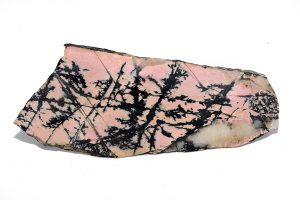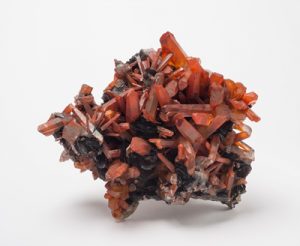Finding rock groupies: Mineral collecting and care
Part II
When did collecting geological samples morph into a hobby? Humans have always been curious about their surroundings, and collecting minerals appeals to the inquisitive mind and eye. There is an innate human curiosity to understand the natural world we live in. Some kids gather shells by the sea, and some collect rocks. Those kids that carry that curiosity into adulthood are tomorrow’s mineral collectors.
In many ways, mineral collecting is very similar to art collecting. Like an art object, a mineral’s value is based on certain factors: rarity, quality, size and condition. Fine minerals, however, are creations of nature rather than the human mind, and hunting down the best specimens can be both a physical and mental exercise.
Rocks above and below
The quest for fascinating mineral specimens often necessitates a search beyond the hiking path. Old mines are a favored destination for amateurs and professionals alike.
Boston-based mineral collector Todd Brooks explains the allure of the quest, “Mines are a destination for mineral collectors because miners pull out everything, not just what they are specifically mining (iron, gold, diamonds etc.). ‘Tailings’ are the rock remnants that the miners consider waste, but can be a treasure chest for the rest of us.”
Mineral clubs often have access to mines, or you can go as an individual. Usually, if you find a mineral, you are allowed to take it—but always be sure to check the mine’s policy before you enter. Like all forays into the natural world, proceed with caution and safety, whether exploring in mines, or handling and displaying sharp, fragile and potentially dangerous minerals.

Rhodonite’s stunning pink color makes it a favorite among some collectors.
Brooks elaborates on one of his favorite locations, “The Betts mine in Plainsfield, MA is an old mine rich in minerals such as Rhodonite. Tiffany & Co. had a line of silverware with pink and black handles. Rhodonite that was mined from this location was used to make the handles. Rhodonite is found in a black rock with an unassuming exterior—you have to crack it open to find the pink inside. Therefore a rock hammer and pick axe are important tools when you go into a mine.”1
It’s not surprising, then, that mineral collecting appeals to inquisitive enthusiasts who enjoy the search for the perfect stone. Brooks, who studied geology, feels at home in a mine, but for those of us without a scientific background who may be a bit wary, how to get started?
Science, aesthetics and expertise
Hikes or museums are two common places where people first notice unusual rock specimens. Dr. Daniel Ksepka, Curator of Science at The Bruce Museum, reminds us, “Any science museum gift shop worth its salt will have small quartz samples, and they are rather pleasantly shaped like what most people would consider an archetypical “crystal” shape—prismatic with a pointed tip.”
Starting with the basics, like a prismatic mineral, allows the nascent collector to understand the principles of mineral collecting. The criteria are often both aesthetic and scientific. The aesthetic is the inherent “ooh-and-aah” factor that one feels when they encounter a stunning specimen—no scientific degree needed. It can difficult to express, but you know when you see a mineral that speaks to you.

Quartz and Hematite. Image: Courtesy of Robert R. Weiner Collection, The Bruce Museum. Photo by Paul Mutino.
Sometimes, two minerals are better than one. This combination of quartz and hematite creates an aesthetically pleasing specimen with prismatic elements.
Scientific appreciation is all about know-how and detective work. It ranges from learning the complexities and development of crystal shapes (for example, the simple prismatic quartz vs. the orthorhombic space group structure of stibnite), to understanding which metals are behind the colors visible in certain minerals. The trace metals determine the characteristics of the mineral’s chemical composition, highly ordered atomic structure and physical properties. Yet it is difficult to find such specimens.
“For inexperienced collectors trying to obtain the best-quality specimen for the best price, a relationship with a dealer who can provide both knowledge of the market and availability of material is a must,” says Dylan Stolowitz, President of Green Mountain Minerals. “Even the most experienced collectors rely on a small network of dealers to keep an ear to the ground for new material, or specimens which become available from old collections and fit their requirements, which are often very refined.”
Every rock has a history – document it!
Once you start collecting a few mineral specimens, you’d be wise to create a system to catalogue your collection. While numerous methods exist (we’ll show you a few in this post!), at the very least you should maintain a record that identifies each specimen with the following information:
- Mineral and varietal names
- Year mined
- Origin details, including the mine name
- Purchase/acquisition price
- Previous history or display
“Establishing criteria for a collection is key,” says Stolowitz. “We help collectors articulate what attracts them to minerals (for example aesthetics, mineral group, size of specimens, locality or country of origin) and work with them to find pieces to fit their budget and taste. Within a set budget, it is always better to find one fine mineral than to acquire ten of lower quality.”
The information you gather and record can be important for your insurance as well. If your minerals are especially valuable, you can schedule your collection on a collectibles policy. If you have many minerals that are in the two and three digit dollar range, a blanket policy with a maximum limit per item may be a more efficient approach for protecting your collection.
Polish your resources
Resources about mineral collecting are as plentiful as sand on the beach (which, by the way, is made up of silica crystals, one of the smallest kinds of quartz!) Rock-solid fans can spend hours devouring advice and images at various online fan sites, as well as trade publications. Here are a few that can help get new collectors started.
- Mineralogical Record
- Rocks & Minerals (print subscription only)
- Rock & Gem
Want a more up-close education? Natural history museums provide spaces to see amazing mineral collections. Professional mineral and gem trade fairs offer world-class specimens, educational forums and the opportunity to connect with other collectors, dealers and curators. Regional mineral shows exist, along with a “Big Four” of international shows:
American Mineral fairs:
European Mineral Fairs:
Rocks, paper, protection
Once you’ve learned about minerals and begun to acquire your own natural treasures, how can you create your own attractive cabinet of curiosities at home? When displaying your mineral collection, it’s best to follow a few best practices. “The value of any collection is greatly enhanced by proper curation and display,” Stolowitz reminds us. “In the area of display, we work with a number of craftsmen who make the bases that allow for display of a particular specimen in a case, orienting it to bring out the best display angle. Advanced LED lighting systems allow for lighting in a home cabinet that is museum-caliber.”
Collecting minerals provides a way to create order in our chaotic, transforming world, while simultaneously marveling at the creative power of its natural forces. It’s also a relaxing and fun exploration that’s sure to spark conversation. With your prized minerals well-documented and on display, why not host a dinner party to invite others into your own kingdom, built of minerals?
To learn more about the history and science behind minerals, as well as essentials for collectors of all backgrounds, check out the first article in this series, Part I: Minerals are the new rock stars.
Katja Zigerlig is Vice President of Art, Wine + Collectibles Advisory at Berkley One (a Berkley Company).
Header image: Courtesy of the Bruce Museum.



